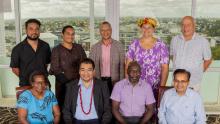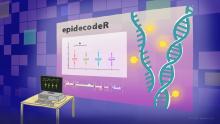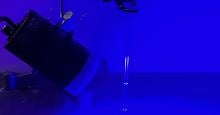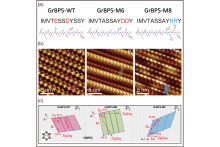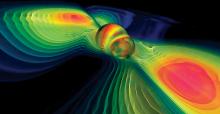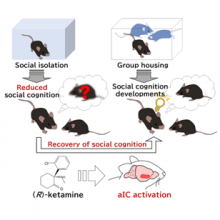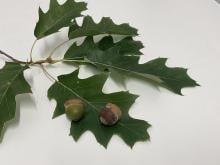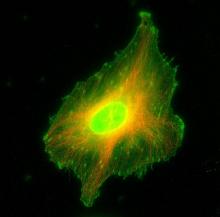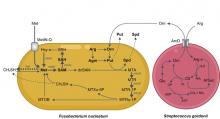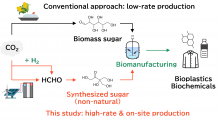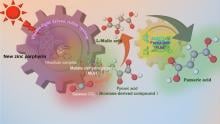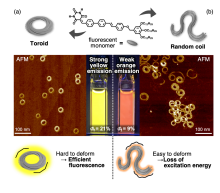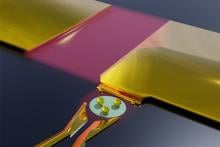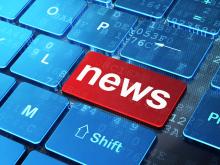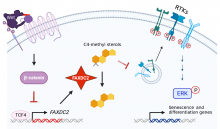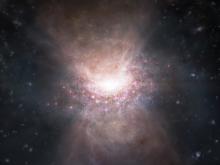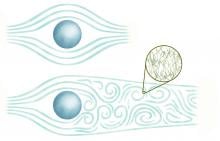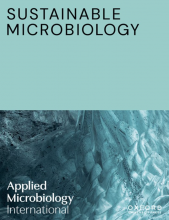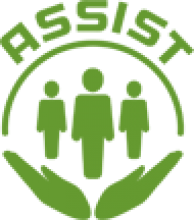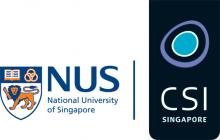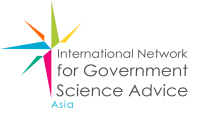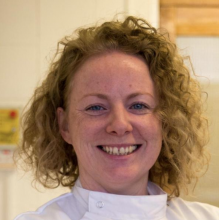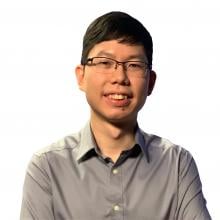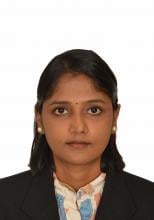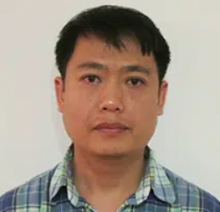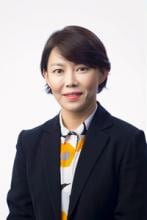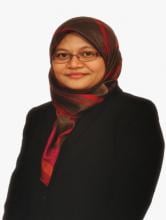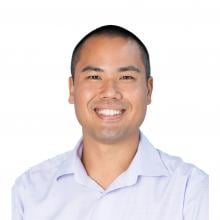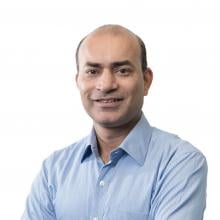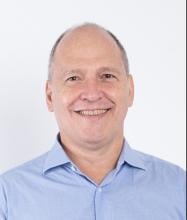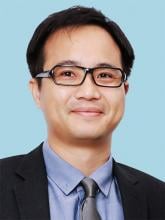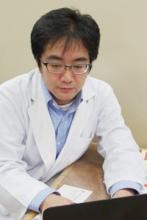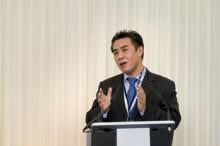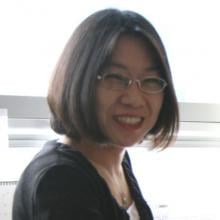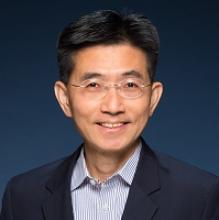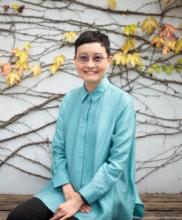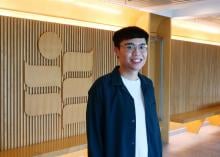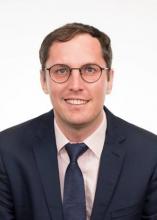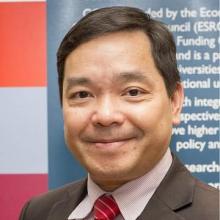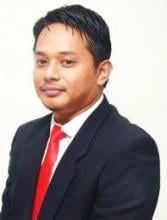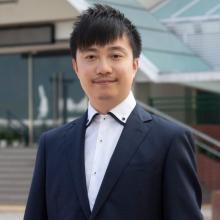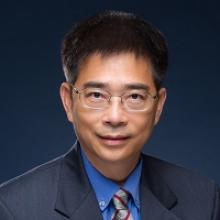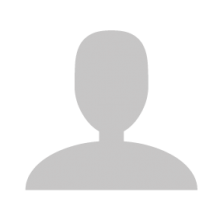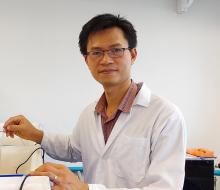Science
News
05 Mar 2024
SANKEN researchers achieved the acceleration of adiabatic evolution of a single spin qubit in gate-defined quantum dots for the first time. After the pulse optimization to suppress quasistatic noises, the spin flip fidelity can be as high as 97.5% in GaAs quantum dots. This work may be useful to achieve fast and high-fidelity quantum computing.
01 Mar 2024
The Pacific is taking a critical step to establish an Academy of Sciences and Humanities to unify and recognize Pacific scholars and their research to inform international decisions about the region.
28 Feb 2024
A new user-friendly tool helps researchers explore how gene activity is influenced by chemical modifications, providing insights into disease and paths to new treatments.
28 Feb 2024
Molecules that are induced by light to rotate bulky groups around central bonds could be developed into photo-activated bioactive systems, molecular switches, and more.
28 Feb 2024
In a study recently published in the journal SMALL, a weekly peer-reviewed scientific journal covering nanotechnology, published by Wiley-WCH, Germany, researchers from Nano Life Science Institute (WPI-NanoLSI), Kanazawa University, Japan, collaborating with Professor Sarikaya, Seattle, USA, used frequency modulated atomic force microscopy to reveal the molecular architecture of genetically designed and point mutated peptides and their self-organizations each forming single-molecule thick, distinct biological crystals on atomically flat graphite and MoS2 surfaces, offering a potential platform for hybrid technologies such as bioelectronics, biosensors, and protein arrays.
27 Feb 2024
Jun’ichi Yokoyama once amused his professors by proposing a far-fetched idea of using neutrinos and gravitational waves to observe the Universe. Decades later, he was proven right and contends young scientists should be nurtured to believe in themselves.
23 Feb 2024
A German aircraft flying out of Cairns is measuring the chemistry of the clouds above Australia and the Pacific.
23 Feb 2024
Researchers from Osaka University have found that, after chronic social isolation, one form of ketamine—(R)-ketamine—is effective for restoring neuronal activation in a brain region known as the anterior insular cortex. This restored activation leads to improvements in social impairments in a mouse model of depression. Together, these findings indicate that (R)-ketamine is a promising treatment for social symptoms of depression and may lead to better quality of life for millions of people worldwide.
22 Feb 2024
The effects of a phenomenon called tree masting on ecosystems and food webs can be better understood thanks to new theoretical models validated by real world observations.
20 Feb 2024
Collective ‘memory’ is one way to ensure that past mistakes in the evolution of science systems are not repeated after a crisis, disaster or conflict according to a University of Tokyo historian who has contributed to the International Science Council’s latest report: Protecting Science in Times of Crisis.
20 Feb 2024
Protecting Science in Times of Crisis is a comprehensive report addressing the urgent need for a new approach to safeguard science and its practitioners during global crises. With many conflicts spread over geographical zones, increasing extreme weather events, and natural hazards such as earthquakes in unprepared regions, this new report takes stock of what we have learned in recent years from our collective efforts to protect scientists and scientific institutions during times of crisis and suggests a way forward.
19 Feb 2024
In a study recently published in Nature Genetics, researchers from Nano Life Science Institute (WPI-NanoLSI), Kanazawa University explore chromatin accessibility, i.e., endogenous access pathways to the genomic DNA, and its use as a tool for gene editing.
16 Feb 2024
Researchers at Kanazawa University report in Journal of Cell Science on a novel role of the small Ca2+-binding protein S100A11 in focal adhesion disassembly.
15 Feb 2024
Researchers from Osaka University found that the oral bacterium Streptococcus gordonii activates another bacterial species, Fusobacterium nucleatum, to produce large quantities of methyl mercaptan, a compound responsible for bad breath. Disrupting this interaction could therefore help treat halitosis, and possibly also help prevent the development of more serious tooth and gum disease.
14 Feb 2024
Researchers from Osaka University and collaborating partners succeeded in biomanufacturing from chemically synthesized sugar for the first time in the world. With refinement of this technology, one can envision a future society in which the sugar required for biomanufacturing can be obtained "anytime, anywhere, and at high rate". In the future, biomanufacturing using chemically synthesized sugar is expected to be a game changer in the biotechnology field—including the production of biochemicals, biofuels, and food, where sugar is an essential raw material—ultimately leading to the creation of a new bio-industry.
14 Feb 2024
An innovative and more efficient way to produce fumaric acid that not only reduces carbon dioxide emissions, but also reuses waste resources to make biodegradable plastics
13 Feb 2024
The properties of supramolecular polymers are dictated by the self-assembled state of the molecules. However, not much is known about the impact of morphologies on the properties of nano- and mesoscopic-scale polymeric assemblies. Recently, a research team demonstrated how terminus-free toroids and random coils derived from the same luminescent molecule show different photophysical properties. The team also presented a novel method for purifying the toroidal structure.
13 Feb 2024
Researchers from the Institute of Industrial Science, The University of Tokyo have solved a foundational problem in transmitting quantum information, which could dramatically enhance the utility of integrated circuits and quantum computing.
13 Feb 2024
AI records rare bird footage, Lighting up IoT and smart cities, Crystal language designs new materials, Detecting toxins with mobile phones, and Dragonfly wings for better aerodynamics. Plus join us for SciCom coffee. Read all in the latest Editor's Choice.
09 Feb 2024
Asia Research News monitors the latest research news in Asia. Some highlights that caught our attention this week are growing placenta organoids, a 90-million-year old fossil, and how COVID-19 can cause insomnia, but people were more relaxed during the emergency measures.
07 Feb 2024
Yokohama National University scientists are working towards creating a better tomorrow by addressing diverse challenges, from snow algae and tropical cyclones to AI cyberthreats, and much more.
06 Feb 2024
The estate of the late Ms Diana Koh gifted S$1M to Duke-NUS Medical School and NUS Medicine to fund young cancer researchers and raise awareness about cancer research advances. The gift establishes research funds, grants, prizes, and learning series to support innovative approaches to cancer treatment by the next generation of scientists and clinicians.
02 Feb 2024
A study led by Duke-NUS Medical School has found an important connection between cancer, stem cells and the building blocks of cholesterol. Specifically, the research reveals how the enzyme FAXDC2 influences cancer cell growth and differentiation through its role in cholesterol synthesis, suggesting possible new approaches to cancer treatment.
01 Feb 2024
Theoretical predictions have been confirmed with the discovery of an outflow of molecular gas from a quasar when the Universe was less than a billion years old.
01 Feb 2024
Researchers from Osaka University and IMRA AMERICA demonstrated a 300 GHz-band wireless link that was able to transmit data over a single channel at a rate of 240 gigabits per second. The wireless communication system employs signal generators based on lasers that have ultra-low phase noise in the sub-terahertz band. This rate is the highest so far reported at these frequencies and is a substantial step forward in 300 GHz-band communications for 6G networks.
31 Jan 2024
Attended by President Ing-wen Tsai, Academia Sinica launched Taiwan's first self-developed 5-qubit superconducting full-stack quantum computer at its quantum computer progress presentation today. During the event, AS President James Liao presented the research team’s self-developed 4-inch quantum wafer to President Tsai. The event was also attended by Chia-Lung Lin, Secretary-General to the President; Tsung-Tsong Wu, Chairman of the National Science and Technology Council and Chuan-Neng Lin, Vice Minister of Economic Affairs. It marks an important milestone in the development of Taiwan's quantum technology.
30 Jan 2024
A team of researchers from Osaka Metropolitan University assessed the feasibility of conducting cardiopulmonary exercise testing with the upper limbs as an alternative to the conventional method that uses the lower limbs. The researchers investigated the relationship between heart rate and oxygen uptake during exercise stress tests using a cycle ergometer and an arm crank ergometer, and estimated maximal oxygen uptake. The study participants were 17 male collegiate athletes from rowing and cycling clubs. The results showed that the estimated maximal oxygen uptake for both rowing and cycling groups was lower on the arm crank ergometer than on the cycle ergometer. Additionally, this study showed that exercise testing using an upper extremity ergometer underestimates cardiopulmonary function, regardless of upper limb training status.
29 Jan 2024
A theoretical framework for measuring the Reynolds similitude in superfluids could help demonstrate the existence of quantum viscosity
24 Jan 2024
This week sees the launch of the first published content in Sustainable Microbiology, the new open access journal which will apply microbiology to sustainability. The journal is published by Applied Microbiology International.
Events

09 Dec 2019
The ASEAN Emerging Researchers Conference is a flagship programme of the ASEAN Young Scientists Network; the official platform for young researchers in the region.
14 Jan 2020
Organised by the National Research Foundation (NRF) Singapore, the Global Young Scientists Summit (GYSS) brings together distinguished scientists, post-graduates and academics for four days of learning and mentoring from 14 to 17 January 2020.
26 Feb 2020
Japan's Leading Exhibition for Pharmaceutical R&D and Manufacturing Technologies!
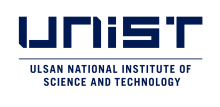
10 Sep 2019
South Korea's Ulsan National Institute of Science and Technology is delighted to announce the HFE Labs’ Demonstration Day is scheduled to be held on September 10, 2019.

South Korea's Ulsan National Institute of Science and Technology (UNIST) has organized a grand celebration event in celebration of the 10th anniversary of its opening and 12th anniversary of its establishment on Tuesday, May 12, 2019.

South Korea's Ulsan National Institute of Science and Technology (UNIST), jointly with Ulsan Metropolitan City, held the "Graphene Symposium in Ulsan" on Wednesday, May 8, 2019.

South Korea's Ulsan National Institute of Science and Technology (UNIST) held a ceremony to mark the official opening of Smart Port Logistics Data Center.
28 Aug 2019
The 2019 Genome Expo is scheduled to be held at UNIST from August 28 to 29, 2019.
03 Oct 2019
Deadline for online registration 20 September 2019!
We are excited to host our 5th annual RNA Biology Symposium by the RNA Biology Centre of CSI Singapore, NUS. It will be held at the Clinical Research Centre (MD11) Auditorium, 10 Medical Drive, Singapore 117597.
06 Nov 2019
The 5th Annual Biopharma Development & Production Asia Pacific is back with a 360˙ view on industry trends, new therapies, technical innovation and many more.

04 Nov 2019
We bring together distinguished cancer researchers with complementary knowledge and expertise
from across the globe for the exchange of ideas and information.
13 Aug 2019
Call for participation. Deadline: 30 April 2019

24 Mar 2019
The Tohoku University Center for Innovative Integrated Electronic Systems (CIES) will host its fifth technology forum in Tokyo from March 24~26.

09 Apr 2019
Science and the Sustainable Development Goals: The role of academies
14 Nov 2019
The goal of this conference is to address the emerging technologies and themes in Microfluidics, Lab-on-a-Chip and Organ-on-a-Chip fields as these areas are expanding and evolving.
11 Nov 2019
The conference addresses the whole ecosystem of Cell & Gene Therapy and 3D-Bioprinting with a focus on 3D-Culture, Organoids, Bioprinting and Technology Platforms being developed to bring cell therapy, gene therapy and regenerative medicine to the clinic.
09 Sep 2019
This conference brings together a focus on technology development as well as applications for biomarker analysis in cancer, cardiovascular disease and other disease classes.
09 Oct 2019
Asia's Premier Partnering Event for the Global Biotechnology Industry

18 Feb 2019
Attaining the Next Frontier for Competitive Advantage with the Game-Changer AR/VR

20 Jan 2019
The Summit provides a platform for conversations on science and research, technology innovation and society, and solutions to global challenges.

11 Dec 2018
The International Network for Government Science Advice Capacity Building Workshop for South Asia on the 11th and 12th of December 2018 at the Banaras Hindu University, Varanasi, India.

28 Feb 2019
The Nagoya Medal Award is awarded every year to two organic chemists who have made significant original contributions to the field. This year’s Gold Medal will be presented to Professor David W. W. MacMillan (Princeton University, USA), and the Silver Medal will be presented to Professor Chihaya Adachi (Kyushu University, Japan).

21 Feb 2019
Asia's Definitive Inventions and Innovations Exhibition

04 Oct 2018
ISTbM-6 with the 14th Hirata Award and the 4th Tsuneko and Reiji Okazaki Award.

19 Mar 2019
Innovation. Access. Commercialisation.

06 Nov 2018
In 2018, the International Network for Government Science Advice (INGSA) will host its 3rd biennial conference on International Science Advice to Government on the 6-7th November 2018 in Tokyo, Japan.

12 Nov 2018
Hear innovative science and benefit from the vast knowledge shared at the FCS 2018!
Researchers
Dr. Crumlish has researched aquatic microbial diseases, specifically ones that have economic impact in global aquaculture, and potential solutions to such infectious diseases. Her current project seeks to develop vaccines against antimicrobial resistance in aquaculture.
The Agency for Science, Technology and Research (A*STAR)
Dr. Tay has researched antibodies and diseases like malaria and SARS-CoV-2 at A*STAR. His focus is on discovering methods for developing antibodies that can be used in therapies against multidrug-resistant pathogens.
Senior lecturer at Universiti Tun Hussein Onn Malaysia and actively involve in research and innovation. Participated in many innovation competition and won accreditation nationally and internationally. Received title Inv. from IFIA for innovators.
Nguyen Huu Nghia is the Director of the Center for Environment and Disease Monitoring in Aquaculture (CEDMA) at the Research Institute for Aquaculture No.1 (RIA1) under Vietnam’s Ministry of Agriculture and Rural Development. He has co-managed various research efforts in Vietnam aquaculture as well as published recent research into the use of nanobubbles.
City University of Hong Kong (CityU)
Dr. An is an associate professor at the School of Energy and Environment, City University of Hong Kong (CityU), where she also heads the Water and Membrane Technologies Laboratory.
Universiti Putra Malaysia (UPM)
Dr. Ikhsan is an associate professor at the Department of Aquaculture, University Putra Malaysia. She specializes in the field of Aquatic Microbial Ecology particularly in the development of innovative and sustainable microbial management strategies through understanding of the host-microbe interaction for enhanced microbial stability.
The Agency for Science, Technology and Research (A*STAR)
Dr. Oehlers leads the Bacterial Pathogenesis Laboratory at A*STAR ID Labs, where he and his colleagues focus on identifying molecular bases of mycobacterial disease and, thus, deploy therapies that address antibiotic resistance in mycobacterial infections.
The Agency for Science, Technology and Research (A*STAR)
Dr. Yue Wang is senior principal investigator at the Antifungal Resistance Laboratory of A*STAR ID Labs, where his body of work focuses on virulence mechanisms of the fungal human pathogen Candida albicans.
The Agency for Science, Technology and Research (A*STAR)
Dr. Singhal serves as senior principal investigator at the Bacterial Immunopathology Lab at A*STAR ID Labs in Singapore. His work at A*STAR ID Labs revolves around three main pathogens: Mycobacterium tuberculosis, Gram-negative bacteria and Dengue virus.
The Agency for Science, Technology and Research (A*STAR)
Dr. Bifani is a principal investigator at A*STAR ID Labs at their Antimicrobial Resistance Lab. He has extensively researched antimicrobial resistance in tuberculosis and malaria. He is also an associate professor and research director at the Yong Yoo Lin School of Medicine, National University of Singapore.
City University of Hong Kong (CityU)
Dr. Yan is an assistant professor at the Department of Biomedical Sciences, City University of Hong Kong (CityU). His current research focuses on developing genomic tools to dissect lncRNA function and mechanism in diseases and to identify genetic variations that contribute to disease pathogenesis.
City University of Hong Kong (CityU)
Dr. Deng is a biomedical scientist with a special interest in bacterial virulence, including gene regulation, signaling pathways, and RNA epigenetics. He has worked on virulence regulation in pathogens to discover new therapies against bacterial infections.
Osaka Metropolitan University
Dr. Ozawa is a Specially Appointed Professor at the Department of Dermatology, Graduate School of Medicine, Osaka Metropolitan University (formerly Osaka City University). His specialized field is skin malignant tumor and surgery.
Kyoto University
Dr. So Iwata is a Professor at the Graduate School of Medicine Kyoto University and the Group Director of the SACLA Science Research Group, RIKEN SPring-8 Center. He has investigated how specialized membrane channels remove antimicrobial drugs from inside bacterial cells.
Dr. Soojin Jang heads the Antibacterial Resistance Research Laboratory at Institut Pasteur Korea, where her team focuses on discovering new antibacterial agents for “superbugs” or bacteria resistant to most antibiotics.
Hong Kong Baptist University (HKBU)
Ricky Wong Man-shing is a Professor of the Chemistry Department at the Hong Kong Baptist University
The Chinese University of Hong Kong (CUHK)
Professor Winnie Mak Wing-sze is the director the of Diversity and Well-Being Laboratory and currently a Professor at the Department of Psychology, the Chinese University of Hong Kong.
The Education University of Hong Kong (EdUHK)
Dr. Randolph Chan's research areas focus on the mental health and positive development of youth from marginalized populations with a particular emphasis on sexual and gender minorities.
Duke-NUS Medical School
Dr Owen Rackham is an expert in the development of computational approaches for cell reprogramming and disease-gene association.
Duke-NUS Medical School
Dr. Sonia Chotani is a computational biologist working in the area of small open reading frames and RNA translation in human diseases.
Hong Kong Baptist University (HKBU)
Dr. Iyaswamy Ashok is currently a Research Assistant Professor at School of Chinese Medicine.
Lingnan University (LU)
Professor Joshua Mok Ka-ho is the Vice-President and concurrently Lam Man Tsan Chair Professor of Comparative Policy of Lingnan University. He researches and publishes on higher education policy and governance, comparative development and policy studies, and social development in contemporary China and East Asia
International Islamic University Malaysia (IIUM)
Dr. Nor Aiman Sukindar has joined International Islamic University Malaysia in 2019 and currently working as Assistant Professor in Manufacturing and Materials Department and at the same time holding a position as Chairman of the Advanced Manufacturing and Material Research Unit (AMTech). Before joining IIUM, Dr. Aiman was working with Politeknik Kuching Sarawak for more than seven years from 2011 until 2019.
Dr. Aiman has extensive experience in research pertaining to additive manufacturing technologies including the design and development of 3D printers, fabricating scaffold structures for bone replacement using biomaterials, optimization printing parameters, and any other related field. Dr. Aiman was awarded grants from industries and the government including PPRN, Tin Grant, and Sponsored research grant.
Recently, Dr. Aiman won several awards including a silver medal in Asia Innovation Festival 2022, Gold Medal in RITEC 2021 Competition in 2021, and a silver medal and Outstanding Award in SDG MTE 2021 Competition also in 2021.
The Education University of Hong Kong (EdUHK)
Dr. Henry Ho is a Registered Psychologist (RP) of the Hong Kong Psychological Society and a Chartered Psychologist (CPsychol) of the British Psychological Society. His current research aims to examine the impact of psychological capital on work performance and well-being.
Hong Kong Baptist University (HKBU)
Prof. Cai Zongwei is now the Chair Professor of Chemistry in the Department of Chemistry and Director of both State Key Laboratory of Environmental and Biological Analysis as well as Dioxin Laboratory, Hong Kong Baptist University.
Daegu Gyeongbuk Institute of Science and Technology (DGIST)
Hoe Joon Kim is currently an Associate Professor in the Department of Robotics & Machatronics Engineering at Daegu Gyeongbuk Institute of Science & Technology (DGIST)
The Education University of Hong Kong (EdUHK)
Dr. Brian Man Yu Bon is currently serving as an Assistant Professor in Department of Science and Environmental Studies, The Education University of Hong Kong.
Duke-NUS Medical School
Dr Kwa is currently a Pharmacy Clinician Scientist and Assistant Director, Pharmacy (Research), at the Singapore General Hospital. She specializes in critical care medicine, infectious diseases and antimicrobial resistance research.
The Asian Institute of Technology
Dr. Dong currently works at the Asian Institute of Technology. He does research in Aquaculture, Pathology, Infectious Diseases, and Aquatic Bioscience.
Giants in history
Chinese biochemist Chi Che Wang (1894 - 1979), one of the first Chinese women to study abroad, advanced to prominent research positions at American institutions including the University of Chicago and the Northwestern University Medical School.
Ruby Sakae Hirose (1904 – 1960) was a Japanese-American scientist whose research contributed significantly to our understanding of blood clotting, allergies and cancer.
Chinese electron microscopy specialist Li Fanghua (6 January 1932 – 24 January 2020) facilitated the high-resolution imaging of crystal structures by eliminating interference.
Sálim Moizuddin Abdul Ali (12 November 1896 – 20 June 1987), commonly referred to as the Birdman of India, was the first person to conduct systematic surveys of birds from across India.
Haisako Koyama (1916 – 1997) was a Japanese solar observer whose dedication to recording sunspots – cooler parts of the sun’s surface that appear dark – produced a sunspot record of historic importance.
Michiaki Takahashi (17 February 1928 – 16 December 2013) was a Japanese virologist who developed the first chickenpox vaccine.
Toshiko Yuasa (11 December 1909 – 1 February 1980) was the first Japanese female physicist whose research on radioactivity shed light on beta decay – the process in which an atom emits a beta particle (electron) and turns into a different element.
Angelita Castro Kelly (1942-2015) was the first female Mission Operations Manager (MOM) of NASA. She spearheaded and supervised the Earth Observing System missions during its developmental stage.
Malaysia’s first astrophysicist, Mazlan binti Othman (born 11 December 1951) was instrumental in launching the country’s first microsatellite, and in sending Malaysia’s first astronaut, Sheikh Muszaphar Shukor, into space.
Known as Mr. Natural Rubber, chemist and researcher B. C. Shekhar (17 November 1929 – 6 September 2006) introduced a number of technical innovations that helped put Malaysia’s natural rubber industry on the world map.
Shinichiro Tomonaga (31 March 1906 – 8 July 1979), together with Richard Feynman and Julian Schwinger, was awarded the Nobel Prize in Physics in 1965, for their contributions to advance the field of quantum electrodynamics. Tomonaga was also a strong proponent of peace, who actively campaigned against the proliferation of nuclear weapons and promoted the peaceful use of nuclear energy.
South Korean theoretical physicist Daniel Chonghan Hong (3 March 1956 – 6 July 2002) achieved fame in the public sphere through his research into the physics of popcorn.
Japanese chemist Kenichi Fukui (4 October 1918 – 9 January 1998) was the first Asian scientist to be awarded the Nobel Prize in Chemistry. Together with Roald Hoffman, he received this honour in 1981 for his independent research into the mechanisms of chemical reactions.
Chinese palaeontologist, archaeologist and anthropologist Pei Wenzhong (January 19, 1904 – September 18, 1982) is regarded as a founder of Chinese anthropology.
Physicist Narinder Singh Kapany (31 October 1926 – 4 December 2020) pioneered the use of optical fibres to transmit images, and founded several optical technology companies. Born in Punjab, India, he worked at a local optical instruments factory before moving to London for PhD studies at Imperial College. There, he devised a flexible fibrescope to convey images along bundles of glass fibres.
Japanese physicist Ukichiro Nakaya (1900-1962) made the world’s first artificial snowflakes. He started his research on snow crystals in the early 1930s at Hokkaido University, where there is an unlimited supply of natural snow in winter. By taking over 3,000 photographs, he established a classification of natural snow crystals and described their relationship with weather conditions.
The field of solid-state ionics originated in Europe, but Takehiko Takahashi of Nagoya University in Japan was the first to coin the term ‘solid ionics’ in 1967. ‘Solid-state ionics’ first appeared in 1971 in another of his papers, and was likely a play on ‘solid-state electronics’, another rapidly growing field at the time.
Charles Kuen Kao (Nov. 4, 1933 to Sept. 23, 2018) was an engineer who is regarded as the father of fibre optics. His work in the 1960s on long distance signal transmission using very pure glass fibres revolutionized telecommunications, enabling innovations such as the Internet.
Chika Kuroda (24 March 1884 – 8 November 1968) was a Japanese chemist whose research focussed on the structures of natural pigments.
Motoo Kimura (13 November 1924 – 13 November 1994) was a Japanese theoretical population geneticist who is best remembered for developing the neutral theory of molecular evolution.
Meghnad Saha (6 October 1893 – 16 February 1956) was an Indian astrophysicist best known for formulating the Saha ionization equation which describes the chemical and physical properties of stars.
Sir Jagadish Chandra Bose (30 November 1858 – 23 November 1937) was a scientist and inventor who contributed to a wide range of scientific fields such as physics, botany and biology.
Osamu Shimomura (27 August 1928 – 19 October 2018) was a Japanese organic chemist and marine biologist who dedicated his career to understanding how organisms emitted light.
Subrahmanyan Chandrasekhar (19 October 1910 – 21 August 1995) was an Indian astrophysicist who studied the structure and evolution of stars.
Joo-myung Seok (November 13, 1908 – October 6, 1950) was a Korean butterfly entomologist who made important contributions to the taxonomy of the native butterfly species in Korea.
Mathematician Maryam Mirzakhani (12 May 1977 – 14 July 2017) was the first and only woman and Iranian to date to win the Fields Medal in 2014 for her work on curved surfaces.
Sir Chandrasekhara Venkata Raman (7 November 1888 – 21 November 1970) was an Indian physicist who performed ground-breaking research in the field of light-scattering.
Mohammad Abdus Salam (29 January 1926 – 21 November 1996) was a theoretical physicist and the first Pakistani to receive a Nobel Prize in science.
Srinivasa Ramanujan (22 December 1887 – 26 April 1920) was a math prodigy and widely considered one of India’s greatest mathematicians. Despite having almost no formal training in mathematics, he made substantial contributions to mathematical analysis, number theory, infinite series and continued fractions.
Gopalasamudram Narayanan Ramachandran (8 October 1922 – 7 April 2001) is best known for developing the Ramachandran plot to understand the structure of short chains of amino acids, known as peptides.
Hitoshi Kihara (1893 – 1986) was one of the most famous Japanese geneticists of the 20th century. One of his most significant contributions was identifying sex chromosomes (X and Y) in flowering plants.
Chien-Shiung Wu (31 May 1912 – 16 February 1997) was an experimental physicist who made several important contributions to nuclear physics. Wu worked on the Manhattan Project – a top-secret program for the production of nuclear weapons during World War II and helped to develop a process for separating uranium into U235 and U238.
Meemann Chang (born 17 April 1936) is a Chinese palaeontologist who studied the fossils of ancient fish to understand the evolution of life. By examining fossils, she uncovered new insights on how vertebrates, animals with a backbone, migrated from the sea and became adapted to live on land.
Bibha Chowdhuri (1913 – 2 June 1991) was an Indian physicist who researched on particle physics and cosmic rays. In 1936, she was the only female to complete a M.Sc. degree at the University of Calcutta.
Lin Lanying (7 February 1918 – 4 March 2003) was a Chinese material engineer remembered for her contributions to the field of semiconductor and aerospace materials. Lanying was born into a family who did not believe in educating girls and she was not allowed to go to school.
Japanese geochemist Katsuko Saruhashi developed the first method and tools for measuring carbon dioxide in seawater




